|
|
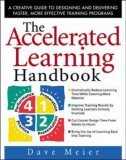 Faster learning Faster learning
Have you ever been bored out of your skull in class? Have you ever left a training session with absolutely no clue what it was about? Have you ever felt dumber at the end of a corporate training?
I have been to such bad training. I have given such awful training sessions.
The “Accelerated Learning Handbook” promises to free us from tedious, slow and ineffective 19th century training. Not a moment too soon!
Accelerated learning is based on a number of principles:
- Learning involves the whole mind and body
- Learning is creation, not consumption
- Collaboration aids learning
- Learning takes place at many levels simultaneously
- Learning comes from doing the work itself (with feedback)
- Positive emotions greatly improve learning
- The image brain absorbs information instantly and automatically.
The four phases
The training is organized into 4 cyclic phases. Each of these 4 steps are detailed, one chapter per phase.
- Prepare the learner. Get the learners out of a passive or resistive mental state; arouse their interest; give them positive feelings and a meaningful relationship with the subject; set clear, meaningful goals; create a positive physical and social environment. Don’t skimp on preparation!
- Presentation. The learning material is presented and the learner is actively involved. Use stories; show links with the real world; involve the body; use interactive presentations, colorful graphics and props. Apply a variety of techniques to appeal to all learning styles; let participants perform partner- or team-based projects; provide discovery exercises and real-world learning experiences. In traditional learning, this is by far the largest and longest phase. In Accelerated Learning, this is a small part of the overall training.
- Practice. Let the learner DO what you’ve presented, let them experience the new material, let them play with the information they were presented. Let participants try, give feedback, reflect and re-try. Use simulations, games and problem-solving activities; make time for individual and team-based reflection and articulation.
- Performance. Apply the learning immediately to the real world, evaluate, give feedback and correct. If the new knowledge is not immediately useful or used, it will fade away very quickly. Plan follow-through reinforcement activities; coach the learners; evaluate performance and give feedback regularly; set up peer support; ensure that the organisation is supportive of the changes.
These same four phases can be found in step 3 (“Transfer knowledge”) of the Toyota training model.
For each phase, the book gives techniques, tips and case studies. Further chapters give additional techniques, like the use of music, setting themes, the use of pictures and graphics, question-raising techniques, learning games (deserves several books on its own), the use (and misuse) of (information) technology… Plenty of useful tips and techniques to dip into when designing training.
Faster teaching
The learner learns faster with Accelerated Learning. The teacher can go faster too! The last part explains the Rapid Instructional Design techniques for developing effective training in record time. Rapid Design uses 7 principles:
- Design for the 4-phase learning cycle
- Appeal to all learning styles, make your learning SAVI (Somatic, Auditory, Visual and Intellectual).
- Make your designs activity based. Start by asking yourself what activities people can engage in before you start thinking about materials and presentation
- Create a learning community. Learning in pairs and groups works a lot faster than individual learning.
- Alternate between physically active and passive learning activities, like “Do, reflect, do…”
- Follow the 30/70 rule: approximately 30% of the time should be devoted to teacher activities (presenting, explaining, feedback), 70% for learner activities (trying, doing, reflecting).
- Create a flexible, open-ended design; be agile, go with the flow.
And what have we learned today?
 This method corresponds with the effective learning sessions I’ve experienced and created. I’ve used this model and the techniques to design training sessions or conference workshops. It works. Portia, Charles and I used these techniques to create and deliver a succesful BOF session at SPA in record time. Portia and I disregarded some of the principles (e.g. alternate between physically active and passive learning activities) when reworking the Real Options session, which resulted in a confusing session. This method corresponds with the effective learning sessions I’ve experienced and created. I’ve used this model and the techniques to design training sessions or conference workshops. It works. Portia, Charles and I used these techniques to create and deliver a succesful BOF session at SPA in record time. Portia and I disregarded some of the principles (e.g. alternate between physically active and passive learning activities) when reworking the Real Options session, which resulted in a confusing session.
The book does have one serious drawback: it doesn’t use Accelerated Learning techniques! The book is all Presentation, there is no Practice or Perfomance. The book would have been a lot more effective if the explanations were followed by exercises where you could apply the techniques that were just explained. The authors should take a look at “Creativity Today“, which does this perfectly.
A big T-H-A-N-K Y-O-U to Portia for this gift. Come and experience our learning when we host a tutorial or workshop at an agile event near you.
Presentation Zen
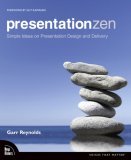 Garr Reynolds has changed my world. By writing a blog. The wisdom in the blog is now collected in a handy book. Garr Reynolds has changed my world. By writing a blog. The wisdom in the blog is now collected in a handy book.
I remember a time when (Powerpoint) presentations were dull, mind-numbing things with bullets. Not much infomation was conveyed, but they were perfect to combat insomnia.
Except in some backward places, boring your audience is frowned upon these days. Real presenters have a message, a story, emotion and meaning. Presenting has become performance art. Presentations have become interesting and exciting.
The ideas that Garr promotes (“Simple ideas on Presentation Design and Delivery”), the examples he gives have inspired so many presenters to become better presenters. These ideas have inspired me to become a better presenter and have more fun doing it.
Playing with presentations
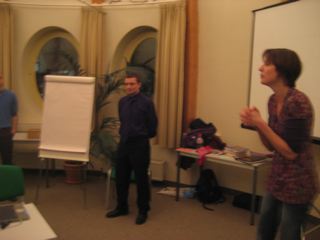 Last Tuesday, Stien and I hosted a “Presentation Zen” night at The Hub Brussels. Simone and Dieter again provided the excellent location and organisation. Last Tuesday, Stien and I hosted a “Presentation Zen” night at The Hub Brussels. Simone and Dieter again provided the excellent location and organisation.
The session was similar to the one Vera and I had given at XP Days Benelux. We first show clips of presenters using different presentation techniques. We let the audience analyze the presentations and note what they like and what they would do to improve the presentation. No negative feedback allowed!
Then, the participants form in groups and make their own presentations. Each group presents what they made and the other participants analyze and give (positive) feedback. The groups then improve their presentation and present the final result.
The teams at work
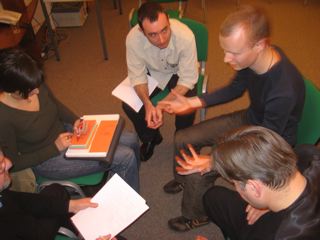 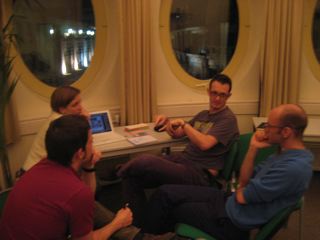
Stien and I put some skin into the game: I presented an excerpt from the “Toyota Way“; Stien and I did a “Go Naked” presentation, where we talked about our preferences and approach to presenting; we also did a “Pecha Kucha“.
Pecha Kucha
Pecha Kucha is a presentation format with very simple rules:
- You get to show 20 slides
- Each slide is shown for 20 seconds. The presentation auto-advances, the presenter is not in control.
- After 20 slides, the presenter(s) sits down and shuts up.
You can get a ‘taste’ of a lot of different presentations on a Pecha Kucha Night. If the subject or presenter isn’t interesting, another one will be along in 6:40 at the most. There are ‘Pecha Kucha Nights’ in most major cities. Go to one of these nights to get some new ideas.
The strict format forced Stien and me to be really clear about what we wanted to present. Our subject was the “creative process” from “Creativity Today“. We applied the process to come up with the presentation. The participants could use this process to come up with their presentation.
We had a lot of fun making the presentation. We played with the conventions of the format. We tried out all sorts of ideas. We included music and silence. We had a lot of fun doing the presentation.
Scary
Pecha Kucha is a scary format. You are not in control. The slides move on inexorably. You can’t hesitate or think too much, you have to present. You have to be present. You have to “throw yourself” into the subject, go with the flow and don’t look back. You have to trust in yourself. You have to trust the other presenter. You have to keep an eye out for your partner’s cues and build upon them.
Stien is a scary co-presenter. And I mean that in the nicest possible way 🙂
Stien is not afraid of improvising, of going with the flow, of trying something else, of moving off script (“Script? What script?”). I’m more the structured, rehearsed type. Our presentation content and delivery played on those differences. The creative process requires both. One without the other is boring or chaotic.
Passion
For me, it all comes down to passion. Talk about something that you are passionate about and let that passion shine through. Use personal elements and stories to connect with the audience. Apply Kanso (simplicity), Shizen (naturalness) and Shibumi (elegance).
Music
Two days later I went to a concert by Wim Mertens. The music was enthralling and moving. The setup was simple: a piano player and a violinist on stage. After a nervous start (this was the premiere of the tour) the playing was natural. The stage setup was simple and elegant. Both players were completely “in” the music, while being intent on the each other’s cues.
When not playing, Wim Mertens seems shy and uncomfortable on stage dealing with the audience’s applause. He looks as if he’d rather not be there, but at home composing or recording some new piece. He seems to play his music because he must. His passion for music makes him go on stage again and again.
If you’re going to do a presentation, do it because you are passionate. Do it because you must.
Pictures by Cyriel.
I’m not creative
“I’m not creative.” How often have I said this to myself?
“I’m not creative.” Have you ever said that to yourself?
“You’re not creative.” Has someone ever said that to you?
“I’m not creative.”. Can you feel your brain cells going to sleep, as you read it? Can you feel your mind getting numb? Sorry about that. Convincing yourself you’re not creative is the worst idea killer. There are many more.
Why don’t you go out and do something creative?
Years ago I saw an interview on TV of some guy whose hobby was computer programming. He talked enthusiastically about a computer game he was writing.
At the end, the interviewer asked “That sure takes up a lot of your time. Why don’t you go out and do something creative instead?”
A long silence ensued, while the programmer tried to find something that would fit the (probably very narrow) definition of creativity the interviewer used.
So, what is your definition of creativity?
Creativity Today
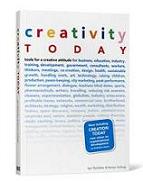
Creativity Today explains the creative process. A process to be creative? Yup. If you want to get results, a good structure is required. I like structure. Creativity Today uses a simple structure with four phases and gives techniques for each phase. The process has many similarities with the Retrospective process. Both processes have the same goal: action plans for innovative improvements. Some tools are used in both processes. In both cases, you need good coaches who can keep the environment safe, avoid ‘idea and innovation killers‘ and keep the focus on forward movement and results.
There are enough techniques and tools to create variation and keep the process ‘fresh’. Each technique is clearly described and analyzed, so that you can select the right tool for the right task. Several techniques are useful in learning settings like training or conference sessions. Come and experience them at one of the many fine agile events around the world.
The book contains plenty of coaching tips, examples and exercises. The layout and structure is (as you might expect) playful and original, but every element is clearly recognizable. This is very useful if you need to look something up.
At the end of the book, there’s a short extra section about organisational creativity. This section contains mostly case studies, less about techniques or approach. After the simple, engaging tone of the main part of the book, the ‘woolly’ language of this section made it hard for me to get the message. To make this part better I would either restrict it to the case studies, which show the techniques at work OR expand this section and provide a process and technique to scale the techniques up from the team to the organisation. And use simpler language.
And? Does it work?
Scintillating Stien and I have just finished a creativity workshop for a customer. We used the process from Creativity Today, with several techniques from the book. We added a few techniques and additions of our own, to make the workshop fit the needs of the task and the customer. The improv’ theater techniques from “En… Actie!“, funny video clips and some music added a good atmosphere and energy between the different segments.
We still need to do the full evaluation, but the first reactions were very positive. We got the results we wanted in the expected time. We tackled some hard problems and had fun doing it. This team now has everything they need, to create what they want to make. You’ll hear more from that team!
Creativity is a skill
Creativity is not something you are ‘born with’. Or rather, we are all born with creative skills, but we have to learn and train to master the skill. We must resist the forces that make us ‘unlearn’ the skills. I have trained, created and learned with the Bold Bootcampers, the Kid Ketjes, Ceaseless Cyriel, Shiny Stien (when can we expect the blog?), Vivacious Vera, Rollicking Rob, Perceptive Portia and all the people I have worked and played with these last years.
Creativity is a team sport.
I’m creative.
You are creative
Go out and do something creative. Today. You know you can.
Action!
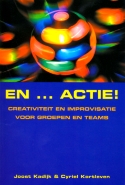 Yesterday I went to a workshop on using improv’ theater techniques for coaching at “The Hub Brussels“. Some years ago, I had attended some ‘matches’ of the ‘Improvisation League’. It was a lot of fun. Those actors were really creative and had the quick wits to deal with the difficult situations they were put in by the game master and their ‘opponents’. But what does acting have to do with coaching? Yesterday I went to a workshop on using improv’ theater techniques for coaching at “The Hub Brussels“. Some years ago, I had attended some ‘matches’ of the ‘Improvisation League’. It was a lot of fun. Those actors were really creative and had the quick wits to deal with the difficult situations they were put in by the game master and their ‘opponents’. But what does acting have to do with coaching?
The workshop was led by Cyriel Kortleven, one of the authors of “En… Actie!“. The book explains why, how and when you can use these techniques when you work with groups. The meat of the book consists of technique descriptions, divided into three settings:
- Generic meetings, getting to know the other participants and creating a safe environment
- Improving improvisation skills, increasing trust, letting go of familiar patterns, becoming aware of body language and accepting new ideas and change
- Stimulating creativity, definining the problem, generating ideas, converging from ideas to solutions
The format of the book is very practical: each technique is preceded by a summary of its goal, duration and max. number of participants, followed by the description and implementation tips. It’s easy to find a suitable technique quickly.
Cyriel introduced several techniques by first letting us perform the exercise and then explaining the technique. Cyriel’s energetic and humourous coaching style quickly got a bunch of strangers moving, acting and laughing.
Another set of useful tools to add to my toolbox. Several techniques are useful for conference sessions.
Unfortunately, the book is only available in Dutch for now. But an English version may appear in the future.
I met people from all walks of life, all with an interest in change and innovation. That’s what “The Hub” is about.
More about creativity later.
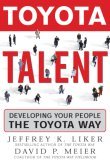
Developing your people the Toyota Way
Yup, another book about the Toyota Way. Gotta feed that habit!
One of the “Toyota Way” principles is to Develop Exceptional People. Well, doesn’t every company do that? Not in my experience. Many are caught in the “No time” vicious cycle. People are firefighting, so they have no time for (effective) training. Because of that, any training they get is ineffective. So their work is ineffective. They have to fight fires. And so on…
There must be a better way. Jeffrey Liker and David Meier delve deeper into the development of exceptional people principle.
Origins
Many of the training methods Toyota uses today are based on “Training Withing Industry” (TWI), a program started up in the USA during World War II. To keep wartime production running with all young men off to war, the USA needed to train a lot of people very well in a very short time. The program was focused on “immediately increasing production for defense, then for war“, but “The training we give the worker to do a good job… can be more than an expedient means of getting the job done. It can be suitable to the individual and in line with native talent and aspiration. Then it becomes education because the worker placed in the line of work he desires, and trained in accordance with his talent and aspirations, is a growing individual…” [preface to the Training Within Industry Report 1940-1945]
After the war, the need wasn’t so pressing any more, so the program was abandoned. TWI was exported to Japan during the post-war reconstruction. So how does Toyota apply TWI?
1. Prepare the organization
You start by defining the organizational needs and objectives. Ask around in your company “Why do we train people? Why do we want to develop the talents of our people?” Make sure that you get measurable objectives: reduce incidents, increase throughput, increase quality… Go to the source (Genchi Genbutsu) to assess the real needs.
Determine how many trainers you need and how the the trainers map to the organizational structure. The book recommends one qualified trainer per 10 employees. In the Toyota Way, these are “workplace trainers”, people who do the work, but are also trained as trainer. Each leader is first and foremost a trainer. Being an effective trainer is not easy. The book contains a list of talents to recruit, select and train trainers.
Training is planned as a long-term commitment. there is an organizational development plan and each employee has a personal development plan. Of course, the status of the training is always visible in a “multifunction worker training table”: a sheet where the team members and their skills are listed. This allows us to see at a glance that the team has a good balance of skills and that each skill is mastered by multiple workers.
2. Identify critical knowledge
First, analyze the work from a high level. One analysis technique looks at task variety (is the content of the work always changing?) vs task analyzability (can the job be broken down into simple steps?). This results in 4 categories of work: Routine, Technician, Craft and Nonroutine. Most jobs contain a mixture of the four. Training techniques are adapted to each type of work. For example: Routine job training is heavily based on standard work and training the job steps until they become “motor memory” and the worker can concentrate on problem recognition, response and solving. Craft job training is based on generic procedures, fundamental skills and guidelines.
For each job, the detailed skills requirements are determined. The skills are broken down into simple tasks. This is heavily dependent on the presence of “Standardized Work” procedures. Standardized work and Job Instruction are two lean practices that reinforce each other. The tasks are analyzed in detail; the critical points and their reasons are highlighted. The job breakdown is documented in training sheets.
3. Transfer knowledge
All the material has been prepared. The trainer now prepares for the instruction itself. One of the main points of the book is preparation, preparation, preparation!
At the start of the training session, the student is prepared: the student is made at ease, the goal of the session is explained. The teacher verifies the current knowledge of the student and gets the student interested in the job.
At first, the teacher presents the operation: major steps are explained, key points are emphasized. The teacher performs the job a second time, now explaining the reasons for the key points. After the demonstrations, the student performs the job. The trainer observes and gives instant feedback. When the student gets proficient at the job, they have to explain the major steps, then the key points, then the reasons, while they’re performing the tasks. Another key point is repetition, repetition, repetition.
The teacher assesses whether the student can 1. perform the job in the standard way and 2. understands why the job is performed this way. When the teacher thinks the student is able, the student performs the real job, at first under supervision.
4. Verify learning and ensure success
Students transition gradually from training to being self-reliant. The teacher monitors regularly. As workplace leaders are often also the teachers, they can offer on the job mentoring. The following tips help the student become self-reliant:
- The trainer is always responsible for the capability of the student. “If the student hasn’t learned, the teacher hasn’t taught“.
- Always support the student
- Explain who to call for help. Asking for help a basic skill that anyone should master.
- Check progress frequently
- Encourage questions
- Gradually reduce coaching and follow-up. Don’t throw the student in at the deep end, to swim or sink.
- Use the cascade audit method to ensure success of the process. Do you achieve the goals (and sub-goals) you set? If not, adjust the training. This closes the positive feedback loop of learning.
It’s not easy
All of this takes sustained effort. Each leader must see it as their first responsibility to develop their people. The whole process must be ingrained in the company. Really developing people takes time; it takes years before new engineers are really up to speed and can take responsibility for important subsystems. It’s easy to undo all this hard work if your employees leave or if they get moved willy-nilly to unrelated teams (as happens in strictly project-based organisations).
The book contains many examples and tools. Most of the examples are from manufacturing, but there are also plenty of examples from engineering and nursing.
There are many useful techniques that I use when creating training or conference sessions. These are essential skills for any leader. How do I know if I lead well? When the product gets better AND the team gets better.
|
 This method corresponds with the effective learning sessions I’ve experienced and created. I’ve used this model and the techniques to design training sessions or conference workshops. It works. Portia, Charles and I used these techniques to create and deliver a succesful BOF session at SPA in record time. Portia and I disregarded some of the principles (e.g. alternate between physically active and passive learning activities) when reworking the Real Options session, which resulted in a confusing session.
This method corresponds with the effective learning sessions I’ve experienced and created. I’ve used this model and the techniques to design training sessions or conference workshops. It works. Portia, Charles and I used these techniques to create and deliver a succesful BOF session at SPA in record time. Portia and I disregarded some of the principles (e.g. alternate between physically active and passive learning activities) when reworking the Real Options session, which resulted in a confusing session.

 Last Tuesday, Stien and I hosted a
Last Tuesday, Stien and I hosted a 



